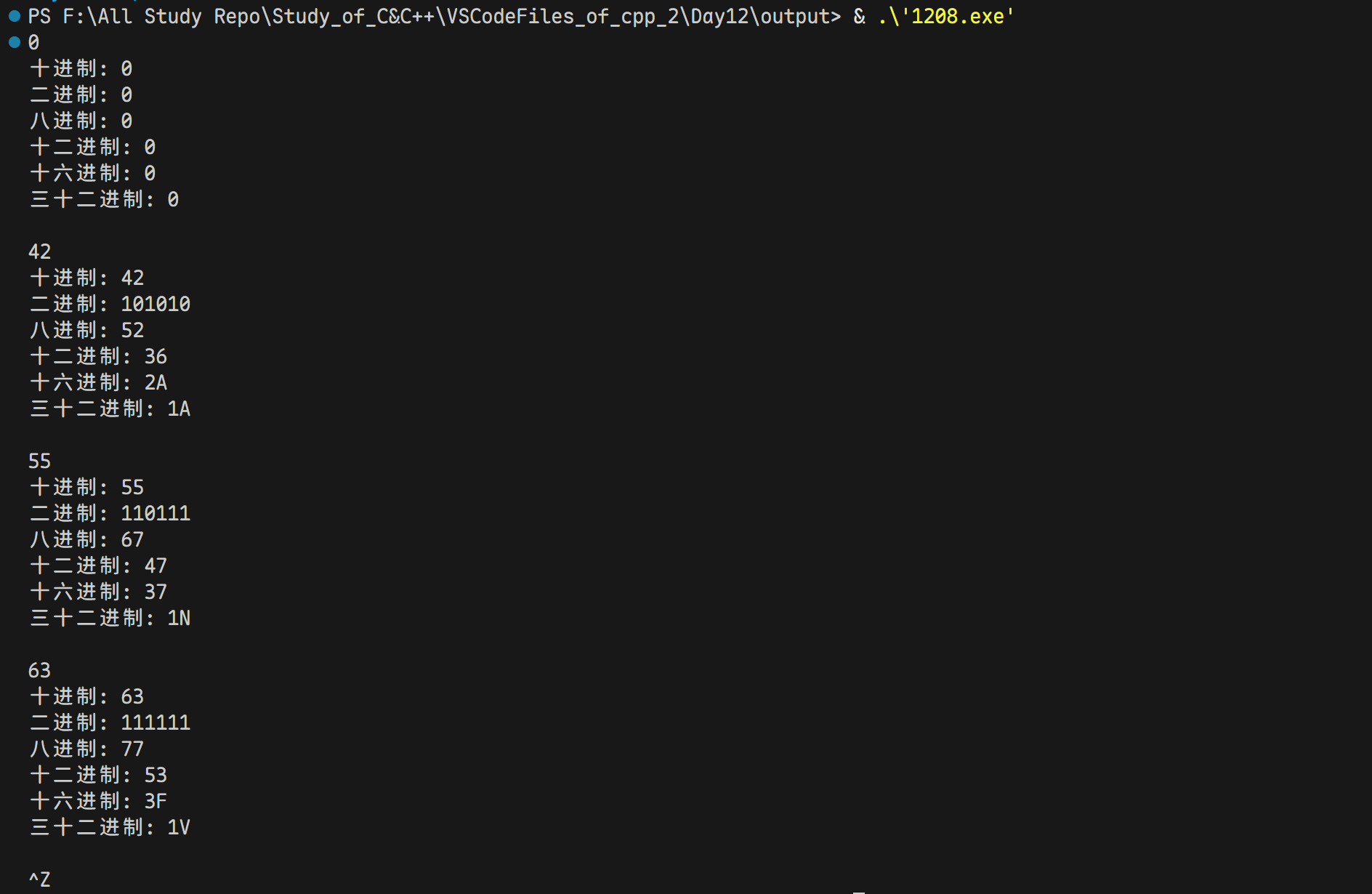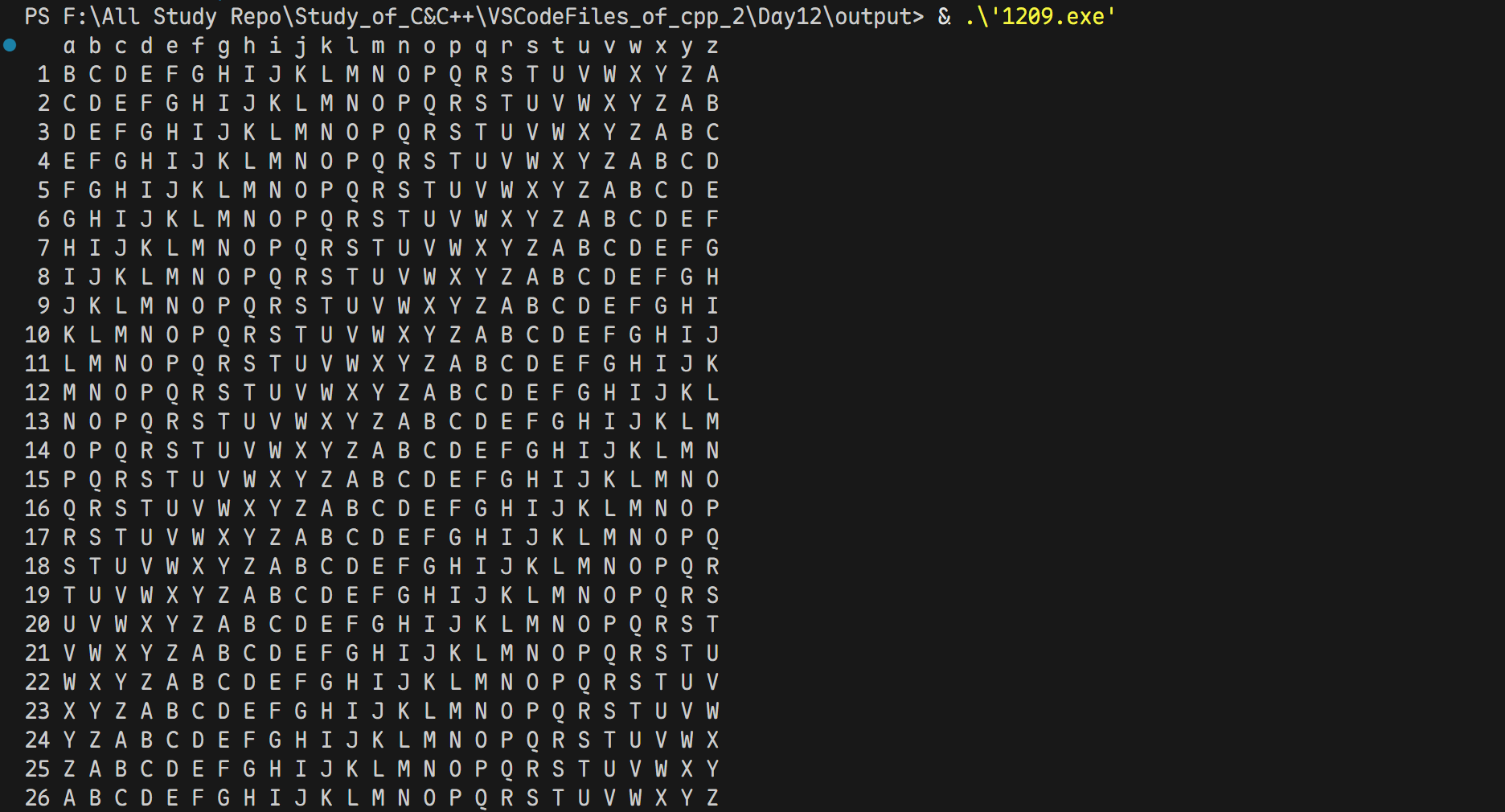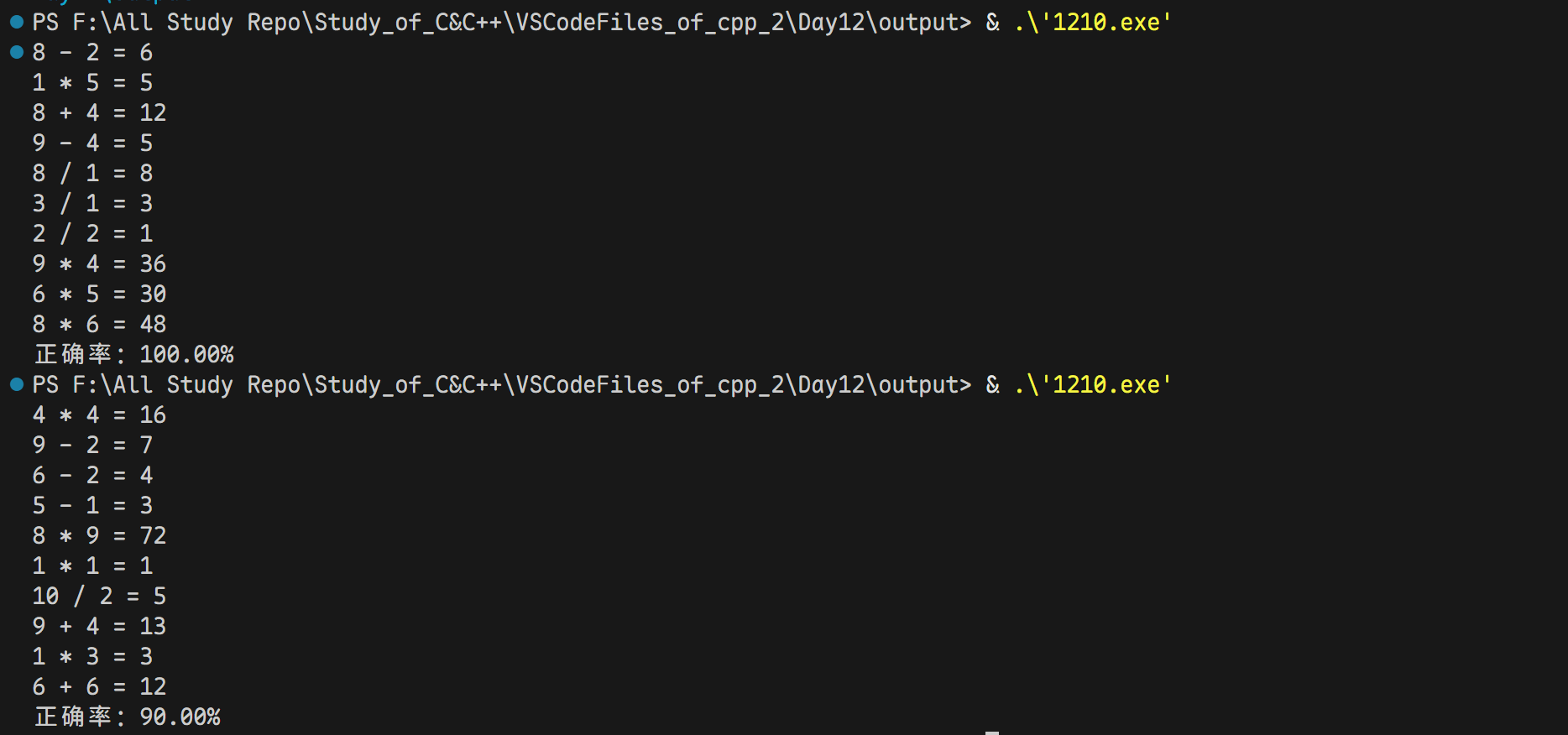OOP实验一
任务一
验证性实验
源码
// 现代C++标准库、算法库体验
// 本例用到以下内容:
// 1. 字符串string, 动态数组容器类vector、迭代器
// 2. 算法库:反转元素次序、旋转元素
// 3. 函数模板、const引用作为形参
#include <iostream>
#include <string>
#include <vector>
#include <algorithm>
// 模板函数声明
template <typename T>
void output(const T &c);
void test1();
void test2();
void test3();
int main()
{
std::cout << "测试1: \n";
test1();
std::cout << "\n测试2: \n";
test2();
std::cout << "\n测试3: \n";
test3();
}
// 输出容器对象c中的元素
template <typename T>
void output(const T &c)
{
for (auto &i : c)
std::cout << i << ' ';
std::cout << '\n';
}
// 测试1:组合使用算法库、迭代器、string反转字符串
void test1()
{
using namespace std;
string s0{"0123456789"};
cout << "s0 = " << s0 << endl;
string s1(s0);
// 反转s1自身
reverse(s1.begin(), s1.end());
cout << "s1 = " << s1 << endl;
string s2(s0.size(), ' ');
// 将s0反转后结果拷贝到s2, s0自身不变
reverse_copy(s0.begin(), s0.end(), s2.begin());
cout << "s2 = " << s2 << endl;
}
// 测试2:组合使用算法库、迭代器、vector反转动态数组对象vector内数据
void test2()
{
using namespace std;
vector<int> v0{2, 0, 4, 9};
cout << "v0: ";
output(v0);
vector<int> v1{v0};
reverse(v1.begin(), v1.end());
cout << "v1: ";
output(v1);
vector<int> v2{v0};
reverse_copy(v0.begin(), v0.end(), v2.begin());
cout << "v2: ";
output(v2);
}
// 测试3:组合使用算法库、迭代器、vector实现元素旋转移位
void test3()
{
using namespace std;
vector<int> v0{0, 1, 2, 3, 4, 5, 6, 7, 8, 9};
cout << "v0: ";
output(v0);
vector<int> v1{v0};
// 将[v1.begin(), v1.end())区间内元素循环左移1位
rotate(v1.begin(), v1.begin() + 1, v1.end());
cout << "v1: ";
output(v1);
vector<int> v2{v0};
// 将[v1.begin(), v1.end())区间内元素循环左移2位
rotate(v2.begin(), v2.begin() + 2, v2.end());
cout << "v2: ";
output(v2);
vector<int> v3{v0};
// 将[v1.begin(), v1.end())区间内元素循环右移1位
rotate(v3.begin(), v3.end() - 1, v3.end());
cout << "v3: ";
output(v3);
vector<int> v4{v0};
// 将[v1.begin(), v1.end())区间内元素循环右移2位
rotate(v4.begin(), v4.end() - 2, v4.end());
cout << "v4: ";
output(v4);
}
结果

回答
reverse会原地修改容器内容,而reverse_copy会将结果写入另一个容器,保留原始数据。rotate(begin, middle, end)会将[begin, middle)区间的元素移到[middle, end)后面,实现循环移位。
任务二
验证性实验
源码
#include <iostream>
#include <vector>
#include <algorithm>
#include <numeric>
#include <iomanip>
#include <cstdlib>
#include <ctime>
// 模板函数声明
template <typename T>
void output(const T &c);
int generate_random_number();
void test1();
void test2();
int main()
{
std::srand(std::time(0));
std::cout << "测试1: \n";
test1();
std::cout << "\n测试2: \n";
test2();
}
// 输出容器对象c中的元素
template <typename T>
void output(const T &c)
{
for (auto &i : c)
std::cout << i << ' ';
std::cout << '\n';
}
// 返回[0, 100]区间内的一个随机整数
int generate_random_number()
{
return std::rand() % 101;
}
// 测试1:对容器类对象指定迭代器区间赋值、排序
void test1()
{
using namespace std;
// 创建一个动态数组对象v0, 对象大小为10
vector<int> v0(10);
generate(v0.begin(), v0.end(), generate_random_number); // 生成随机数填充v0
cout << "v0: ";
output(v0);
vector<int> v1{v0};
sort(v1.begin(), v1.end()); // 对整个vector排序
cout << "v1: ";
output(v1);
vector<int> v2{v0};
sort(v2.begin() + 1, v2.end() - 1); // 只对中间部分排序,不包含首尾元素
cout << "v2: ";
output(v2);
}
// 测试2:对容器类对象指定迭代器区间赋值、计算最大值/最小值/均值
void test2()
{
using namespace std;
vector<int> v0(10);
generate(v0.begin(), v0.end(), generate_random_number);
cout << "v0: ";
output(v0);
// 求最大值和最小值
auto min_iter = min_element(v0.begin(), v0.end());
auto max_iter = max_element(v0.begin(), v0.end());
cout << "最小值: " << *min_iter << endl;
cout << "最大值: " << *max_iter << endl;
// 同时求最大值和最小值
auto ans = minmax_element(v0.begin(), v0.end());
cout << "最小值: " << *(ans.first) << endl;
cout << "最大值: " << *(ans.second) << endl;
// 求平均值
double avg1 = accumulate(v0.begin(), v0.end(), 0.0) / v0.size();
cout << "均值: " << fixed << setprecision(2) << avg1 << endl;
sort(v0.begin(), v0.end());
double avg2 = accumulate(v0.begin() + 1, v0.end() - 1, 0.0) / (v0.size() - 2);
cout << "去掉最大值、最小值之后,均值: " << avg2 << endl;
}
结果

回答
generate用于批量填充容器,结合 lambda 表达式可简化代码。minmax_element一次遍历即可找出最大最小值,效率优于分别调用min_element和max_element。
任务三
验证性实验
源码
#include <iostream>
#include <string>
#include <algorithm>
#include <cctype>
unsigned char func(unsigned char c);
void test1();
void test2();
int main()
{
std::cout << "测试1: 字符串大小写转换\n";
test1();
std::cout << "\n测试2: 字符变换\n";
test2();
}
unsigned char func(unsigned char c)
{
if (c == 'z')
return 'a';
if (c == 'Z')
return 'A';
if (std::isalpha(c))
return static_cast<unsigned char>(c + 1);
return c;
}
void test1()
{
std::string s1{"Hello World 2049!"};
std::cout << "s1 = " << s1 << '\n';
std::string s2;
for (auto c : s1)
s2 += std::tolower(c);
std::cout << "s2 = " << s2 << '\n';
std::string s3;
for (auto c : s1)
s3 += std::toupper(c);
std::cout << "s3 = " << s3 << '\n';
}
void test2()
{
std::string s1{"I love cosmos!"};
std::cout << "s1 = " << s1 << '\n';
std::string s2(s1.size(), ' ');
std::transform(s1.begin(), s1.end(), s2.begin(), func);
std::cout << "s2 = " << s2 << '\n';
}
结果

回答
transform的第3个参数是输出位置,若改为s1.begin()会覆盖原始字符串。func实现了字符的“+1”变换,遇到边界字符则循环回起点。
任务四
判断回文串
源码
#include <iostream>
#include <string>
#include <algorithm>
using namespace std;
bool is_palindrome(const string &s);
bool is_palindrome_ignore_case(const string &s);
int main()
{
using namespace std;
string s;
// 多组输入,直到按下Ctrl+Z结束测试
while (cin >> s)
{
cout << boolalpha << "区分大小写: " << is_palindrome(s) << "\n"
<< "不区分大小写: " << is_palindrome_ignore_case(s) << "\n\n";
}
}
bool is_palindrome(const string &s)
{
for (int i = 0; i < s.size() / 2; i++)
{
if (s[i] != s[s.size() - i - 1])
return false;
}
return true;
}
bool is_palindrome_ignore_case(const string &s)
{
string s1;
for (auto c : s)
s1 += toupper(c);
return is_palindrome(s1);
}
结果

回答
- 若要支持空格输入,可将
cin >> s改为getline(cin, s).
任务五
进制转换
源码
#include <iostream>
#include <string>
#include <algorithm>
std::string dec2n(int x, int n = 2);
int main()
{
int x;
while (std::cin >> x)
{
std::cout << "十进制: " << x << '\n'
<< "二进制: " << dec2n(x) << '\n'
<< "八进制: " << dec2n(x, 8) << '\n'
<< "十二进制: " << dec2n(x, 12) << '\n'
<< "十六进制: " << dec2n(x, 16) << '\n'
<< "三十二进制: " << dec2n(x, 32) << "\n\n";
}
}
std::string dec2n(int x, int n)
{
if (x == 0)
return "0";
std::string s;
while (x > 0)
{
int r = x % n;
s += (r < 10) ? ('0' + r) : ('A' + r - 10);
x /= n;
}
reverse(s.begin(), s.end());
return s;
}
结果

任务六
打印字母密文对照表
源码
#include <iostream>
#include <string>
#include <iomanip>
#include <algorithm>
using namespace std;
int main()
{
std::string s;
std::string s1;
for (char c = 'a'; c <= 'z'; c++)
{
s += c;
}
std::cout << right << std::setw(2) << " ";
for (auto c : s)
{
std::cout << std::right << std::setw(2) << c;
s1 += std::toupper(c);
}
cout << endl;
for (int i = 1; i <= 26; i++)
{
std::cout << std::right << std::setw(2) << i;
std::rotate(s1.begin(), s1.begin() + 1, s1.end());
for (auto c : s1)
{
std::cout << std::right << std::setw(2) << c;
}
cout << endl;
}
return 0;
}
结果

任务七
大学生快乐器
源码
#include <iostream>
#include <cstdlib>
#include <ctime>
#include <iomanip>
using namespace std;
char getsign(int sign)
{
switch (sign)
{
case 0:
return '+';
case 1:
return '-';
case 2:
return '*';
case 3:
return '/';
default:
return 0;
}
}
int calculate(int sign, int num1, int num2)
{
switch (sign)
{
case 0:
return num1 + num2;
case 1:
return num1 - num2;
case 2:
return num1 * num2;
case 3:
return num1 / num2;
default:
return 0;
}
}
int main()
{
srand(static_cast<unsigned>(time(0)));
int num1, num2;
int correctCount = 0;
int userAnswer;
for (int i = 0; i < 10; ++i)
{
int sign = rand() % 4;
do
{
num1 = rand() % 10 + 1;
num2 = rand() % 10 + 1;
if (sign == 1 && num1 < num2)
continue;
if (sign == 3 && (num2 == 0 || num1 % num2 != 0))
continue;
break;
} while (true);
cout << num1 << ' ' << getsign(sign) << ' ' << num2 << " = ";
cin >> userAnswer;
if (userAnswer == calculate(sign, num1, num2))
{
++correctCount;
}
}
cout << "正确率:" << fixed << setprecision(2)
<< (correctCount / 10.0) * 100 << "%" << endl;
return 0;
}
结果

碎碎念
c++好哇, 标准库好哇, 面向对象好哇, 就是Python写多了再写c++好别扭啊...


 浙公网安备 33010602011771号
浙公网安备 33010602011771号